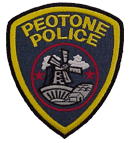ILLINOIS WINDMILLS
Dedicated to the history, preservation, and continuing story of windmills in Illinois.

Peotone Windmill
H. A. Rathje Windmill
Status
Non-operational
Tours
Tours are available during open hours and upon request.
Hours
Early Spring through Late Fall
Sunday: 11:00 A.M. to 3:00 P.M.
Closed / non-operational during winter.
Wheelchair Accessible
No access.
Website
Tower Height
57'
Sail Span
(unknown)
Uses
(1872 - 1899) Wheat
(1872 - 1899) Corn
(1872 - 1899) Feed
(1874 - 1899) Buckwheat
(1874 - 1899) Rye
Constructed
(1871 - 1872) Original
(1997 - present) Restoration
Millwrights
Frederick Rathje (Original)
Christopher Elling (Original)
City of Peotone (Restoration)
Owners
Frederick Rathje (1871 - 1874)
Henry A. Rathje (1874 - 1931)
Paul W. Rathje (1931 - ?)
Paul C. Rathje (? - 1986)
City of Peotone (1986 - present)
Honors
National Register of Historic Places
Will County Register of Historic Places
Sources
-
The H. A. Rathje Mill. Historical Society of Greater Peotone, 1987.
-
Margo Hupe of the Peotone Historical Society.
-
Personal records / observations.
Historic Photographs
 |
|---|
 |
 |
 |
 |
 |
 |
 |
 |
 |
 |
 |
 |
 |
 |

The Peotone Windmill
Photo by Tom Haskell
History of the Mill
The Peotone Windmill sits idle without its sails or grinding machinery for the time being as annual Old Mill festivals are held at the base of the empty, deteriorating tower. It is almost too difficult to imagine that this dilapidated octagonal structure was once a thriving flour mill that put Peotone on the map. Still, the structure is not only the tallest in town (even without sails), but also one of the most important. Of all the custom mills built in the state, it is one of very few examples of a German smock mill.
Fifteen years after the small farming community of Peotone was founded, it was evident that a local mill would be an asset to the town. On July 3, 1871, an agreement was written to construct a new windmill in Peotone by locals Frederick Rathje and Christoph Elling. Using local resources (oak timber and locally quarried limestone), the mill was completed and operating just one year later. As the 1873 Atlas of Will County describes, the mill had “two run of stones, and is doing a successful and satisfactory business.”
After marrying Wilhelmina Luhmann in 1874, Frederick’s son, Henry A. Rathje, acquired the windmill and established his milling business. Henry expanded his operations to include a variety of grains; in its prime, the Peotone Windmill ground wheat, buckwheat, rye, corn, and feed for locals as well as travelers. Surplus flour from the miller’s toll was stored in the west wing of the building, which was later demolished. Rapid deterioration of the sails forced Henry to have them removed and convert the mill to steam power; however, the higher cost of operating the steam engine along with the decline of wheat farming in Illinois probably made milling less than profitable and caused Henry to stop operating the mill altogether sometime around 1889. Competition from new technology and other area mills also undoubtedly led to the mill’s closure. The windmill was definitely out of commission by 1900, as it is written in the Genealogical and Biographical Record of Will County; around this time, the stones and other grinding machinery were removed from the mill and sold.
Henry’s son Paul W. Rathje inherited the mill and the farm after Henry’s death in 1931; Paul C. Rathje inherited the site thereafter. Sometime during the late 1960s, when Corning Avenue was repaved, the road leading to the windmill was eliminated (a road once led to the mill entrance from Corning Avenue at an angle to the northwest). Realizing the importance of the mill to Peotone’s history, Paul C. donated the windmill to the city of Peotone in 1982. The farmhouse next to the mill is still home to the Rathje family.
Over the next decade, the windmill was subject to small improvement projects; a new stage was installed, new shingles were hung, and the village allowed the mill to be open for touring. As part of the city’s effort to boost the image of the windmill, Peotone installed new sails in October of 1997; fate, however, would bring them back down. Lightning struck the mill in November, damaging one of the sails, and an ice storm brought down another in February of 1998. The sails were removed again soon after.
The Historical Society of Greater Peotone decided to push the idea of fully restoring the mill in 2000 after a report was generated by Derek Ogden on its condition. Mostly through donations, the Historical Society is gradually funding the mill’s restoration. A second assessment by Lucas Verbij was performed in 2006 revealing that, curiously, the grinding would have been done on the first floor, and that there were probably three run-of-stone.